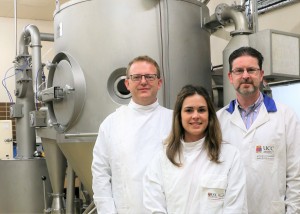Protein2Food Develops Novel Plant-Based Infant Formula

The demand for innovative plant-based infant formulas is growing, especially with the increasing vegan and vegetarian communities seeking healthy and sustainable plant-based alternatives for themselves, as well as their babies.
Soy-based protein infant formulas are the main plant-based protein source used for non-dairy infant formula products, yet soybean allergy has been found in babies and children[1], and soybean production is not the most sustainable[2]. As such, alternative plant-based and hypoallergenic formulas are in increasing demand.
Infant formula is used to satisfy the nutritional needs of infants, as a substitute for human break milk, yet breast milk has a highly complex and unique nutritional profile. So, formulas must consist of protein, fat and carbohydrates, while also being fortified with important micro-nutrients[3]. The processes involved with creating infant formulas involve thermal processing, evaporation and spray-drying to produce the powder. For this reason, it is important to identify plant-based protein sources that have good functional properties such as the ability to dissolve (solubility), to mix with other liquids (emulsification properties) and to stay stable during thermal processing (pasteurisation and ultra-high temperature treatments). On top of this, proteins from plant-based sources can be challenging for food product developers as they usually have lower protein quality and poor technological characteristics (e.g., low solubility and poor heat stability) compared to animal-based proteins.
Since the beginning of the project, researchers at University College Cork (UCC) have studied different protein-rich crops (e.g. quinoa, amaranth and buckwheat) and protein ingredients (e.g. lupin and lentil isolates) to understand their nutritional quality and technological performance, to find the most optimum plant-based protein to be used for infant formula prototypes.
Lentil-based formulas were found to represent an attractive alternative to those with soy proteins, as lentils have a well-balanced amino acid profile (high-quality profile) and are high in protein, meaning they can best satisfy the nutritional needs of the infants as a substitute for human breast milk. Using experimental lentil protein isolate ingredients, from the PROTEIN2FOOD project partners at Fraunhofer Institute, a model infant formula prototype (in powder form) was developed, that has both a well-balanced protein (amino acid) profile and good technological properties. The next steps for the lentil-based formula involve spray-drying, a method of producing dry powder from liquids, which works very well for heat-sensitive ingredients, then to distribute the final product to other project partners to study the nutritional content of the powder. So, cheers to that!
For more information regarding how far the prototype is from entering the market, head over to our Temperature Check on the Prototypes article.
- Formula.
[1] EFSA (2014). Scientific Opinion on the evaluation of allergenic foods and food ingredients for labelling purposes. EFSA Journal 12(11). Available from: https://efsa.onlinelibrary.wiley.com/doi/10.2903/j.efsa.2014.3894. [Accessed 17th May 2019].
[2] Poore J & Nemecek T (2018). Reducing food’s environmental impacts through producers and consumers. Science 360;987-992.
[3] EFSA (2014). Scientific Opinion on the essential composition of infant and follow-on formulae. EFSA Journal 12(7):3760. Available from: https://www.efsa.europa.eu/en/efsajournal/pub/3760. [Accessed 17th May 2019].
School of Food and Nutritional Sciences
Contact us
School of Food and Nutritional Sciences, Room 240 Food Science Building, University College, Cork
